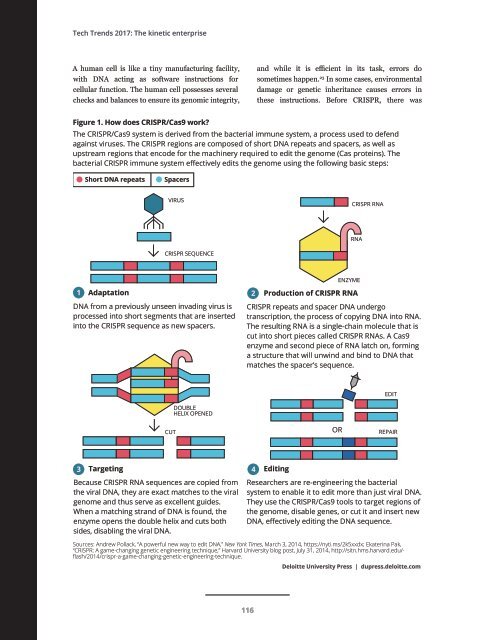Trending the trends Eight years of research
2kcf8xh
2kcf8xh
Create successful ePaper yourself
Turn your PDF publications into a flip-book with our unique Google optimized e-Paper software.
hnology<br />
Tech Trends 2017: The kinetic enterprise<br />
A human cell is like a tiny manufacturing facility,<br />
with DNA acting as s<strong>of</strong>tware instructions for<br />
cellular function. The human cell possesses several<br />
checks and balances to ensure its genomic integrity,<br />
and while it is efficient in its task, errors do<br />
sometimes happen. 23 In some cases, environmental<br />
damage or genetic inheritance causes errors in<br />
<strong>the</strong>se instructions. Before CRISPR, <strong>the</strong>re was<br />
Figure 1. How does CRISPR/Cas9 work?<br />
The CRISPR/Cas9 system is derived from <strong>the</strong> bacterial immune system, a process used to defend<br />
against viruses. The CRISPR regions are composed <strong>of</strong> short DNA repeats and spacers, as well as<br />
upstream regions that encode for <strong>the</strong> machinery required to edit <strong>the</strong> genome (Cas proteins). The<br />
bacterial CRISPR immune system effectively edits <strong>the</strong> genome using <strong>the</strong> following basic steps:<br />
Short DNA repeats<br />
Spacers<br />
VIRUS<br />
CRISPR RNA<br />
RNA<br />
CRISPR SEQUENCE<br />
ENZYME<br />
1<br />
Adaptation<br />
DNA from a previously unseen invading virus is<br />
processed into short segments that are inserted<br />
into <strong>the</strong> CRISPR sequence as new spacers.<br />
2 Production <strong>of</strong> CRISPR RNA<br />
CRISPR repeats and spacer DNA undergo<br />
transcription, <strong>the</strong> process <strong>of</strong> copying DNA into RNA.<br />
The resulting RNA is a single-chain molecule that is<br />
cut into short pieces called CRISPR RNAs. A Cas9<br />
enzyme and second piece <strong>of</strong> RNA latch on, forming<br />
a structure that will unwind and bind to DNA that<br />
matches <strong>the</strong> spacer’s sequence.<br />
EDIT<br />
DOUBLE<br />
HELIX OPENED<br />
CUT OR REPAIR<br />
3<br />
Targeting<br />
Because CRISPR RNA sequences are copied from<br />
<strong>the</strong> viral DNA, <strong>the</strong>y are exact matches to <strong>the</strong> viral<br />
genome and thus serve as excellent guides.<br />
When a matching strand <strong>of</strong> DNA is found, <strong>the</strong><br />
enzyme opens <strong>the</strong> double helix and cuts both<br />
sides, disabling <strong>the</strong> viral DNA.<br />
4 Editing<br />
Researchers are re-engineering <strong>the</strong> bacterial<br />
system to enable it to edit more than just viral DNA.<br />
They use <strong>the</strong> CRISPR/Cas9 tools to target regions <strong>of</strong><br />
<strong>the</strong> genome, disable genes, or cut it and insert new<br />
DNA, effectively editing <strong>the</strong> DNA sequence.<br />
Sources: Andrew Pollack, “A powerful new way to edit DNA,” New York Times, March 3, 2014, https://nyti.ms/2k5xxdx; Ekaterina Pak,<br />
“CRISPR: A game-changing genetic engineering technique,” Harvard University blog post, July 31, 2014, http://sitn.hms.harvard.edu/-<br />
flash/2014/crispr-a-game-changing-genetic-engineering-technique.<br />
Deloitte University Press | dupress.deloitte.com<br />
116


